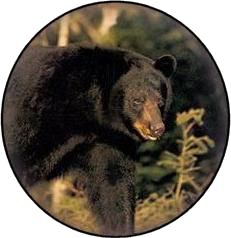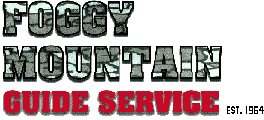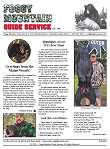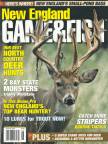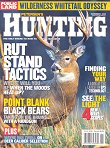

Peterson’s Hunting Magazine, November 2006
When pursuing big bruins with a handgun, bring enough fire power and an expert guide who can put you on the animal before the animal puts himself on you. For that job, there’s none better than outfitter Wayne Bosowicz.
By Dick Metcalf
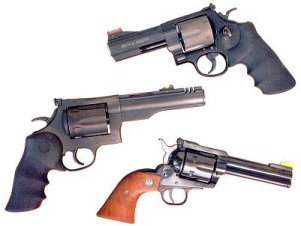
The black bear is the only animal in the continental U.S. that can provide the average hunter a reasonably accessible opportunity to hunt dangerous game – game with fangs and claws rather than horns and hooves. Grizzlies, wolves or mountain lions are rare and tightly regulated. For a hunter of ordinary means, a dream safari to Africa or Alaska will never be anything but just a dream. If an ordinary working guy wants to see what it’s like to confront the chilly reality of quarry that’s truly capable of eating him, black bears are it.
Dangerous? Black bears? Are You kidding? Nope. Though they’re not generally regarded as such, black bears (Ursus Americanus) are dangerous, powerful, crafty and tenacious. They cause more human harm than do far more ill-reputed grizzlies. Here’s a flat statement of fact from famed wildlife expert Leonard Lee Rue III: “Black bears cause more deaths and injuries to people each year than all the other bears combined.”
They are not to be taken lightly, even by the most skilled, well-armed and knowledgeable hunter. A black bear can sprint 100 yards at up to thirty-five mph. Adults boars aver- age about 300 pounds, sows average about half that. A big bear is 400-plus pounds, and 500-plus-pound sows have been recorded in Maine. A large boar’s claws are nearly as long as your fingers.
Black bears reside in portions of at least forty states with documented irregular presence in the remaining ten. They have an extremely acute sense of smell, and their hearing and eyesight are much better than commonly believed, making them extremely wary and skilled at avoiding humans. And therein lies the rub when hunting them with handguns. Getting a reasonable handgun shot requires a lot of knowledge and hunting skill, or the services of an extremely good guide.
Wayne Bosowicz is the best black bear guide I know of. His Foggy Mountain Guide Service is widely recognized as the leading black bear operation in the U.S. I’ve used handguns to hunt bears with Wayne for nearly twenty years. What little I know about these mysterious, reclusive animals, I’ve learned from him.
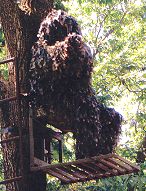
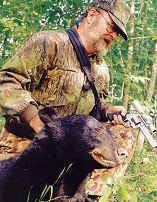
Bosowicz says that in Maine, or anywhere, there are only three ways to hunt black bears. One is to still-hunt through the dense woods. To be successful, you have to be extremely knowledgeable about the bear’s habits as a species, know any peculiarities and patterns of the bears where you are hunting, be intimately acquainted with the terrain and very good at moving silently and scentlessly. For these reasons, the success ratio for still-hunting is very low; only the most serious local bear hunters regularly succeed.
A second way is to use hounds, the techniques of which are not greatly different than hunting other game with dogs. When a bear is scented, the pack is loosed and the hunters follow the pursuit until the bear is treed. Then comes a hasty, exhausting rush to reach the site before the bear comes down the tree and goes through the dogs like a buzz saw. Extremely strenuous for dogs and men, this method offers a very good success ratio in areas with a heavy bear population, and it’s highly favored by hunters whose love is more for the dogs than for the hunt itself. Bosowicz uses plott hounds, a breed he has helped to define, and for which he has won numerous awards.
The third method is to hunt over bait either from a ground-blind or a treestand (the way Ive hunted at Foggy Mountain). In deep, tangled woods, a baited stand gives a hunter barely a break-even chance. Visibility is extremely limited. Even from a treestand, you can see little farther than fifty feet. The quiet is overpowering, and the slightest rustle can be heard thirty yards away. An effective stand must be positioned literally on top of the bait, seldom more than fifty feet away; the stand I used in 2004 put my nose exactly twenty-five feet from the bait pile.
Absolute discipline and concentration are essential when hunting over bait. While you sit unaware, bears may often circle you, testing the wind for any hint of an alien presence. Unless you’re motionless, silent and scent-free at all times, he’ll never appear at all, and you’ll never know he was even near. And if the bear does come, it’s still extremely unlikely you’ll have a hint of his presence until he’s actually at the bait, where he’ll be close enough for you to smell him.
Even when the bear is in front of you, it’s not easy. If he catches the slightest hint of your presence – the sound of a hammer cocking, your breathing – he’s either gone in a blink or he’s coming for your face. From the instant you realize he’s there, you have about two seconds to make a shot. Black bears are tough, hard to kill and hard to track when wounded. Even a good heavy-caliber, knock-him-down lung or heart shot may not keep a bear from getting back up and running off. And even a good lung or heart shot may not result in a blood trail. Wounded bears tend to bleed into the porous fat layers between hide and muscle, and their thick fur absorbs external bleeding like a sponge. Which is why experienced bear hunters will tell you it’s essential to hit a bear hard and solid, and put him down and keep on hitting him until there’s no chance he’ll get up and out of your sight. This is why the right choice of gun, load and sights are very important, particularly for the handgunner.

After several seasons of hunting with Foggy Mountain, I’ve concluded that a heavy-caliber, big-bore handgun is actually a better choice for dense-woods bear hunting than a long gun, particularly if there is any chance you might have to work on the ground. The main reason is that a handgun is quicker and more maneuverable in a heated encounter in thick underbrush. And in spite of my love for the T/C Contender or Encore for many types of hunting, I strongly recommend a revolver over a single-shot pistol for bear hunting. Of course, I can already hear my friends in the T/C Contender Association saying, “One shot is all you should need, Dick.” No argument. It’s just that hunting anything that has teeth sharper than my own makes me very cautious.
So for black bear hunting I’ll opt for a revolver with fiber-optic-enhanced open sights that are highly visible for instantaneous alignment in dim light on dark backgrounds. I’ve seen many handgunners in my years at Foggy Mountain using scopes and electronic dot-type units. Many have been successful. My own experience is that optical sights are not helpful in dim light at close quarters. When they are aimed down from a treestand toward dark, shadowed ground, the reflection of the brighter overhead sky in the eyepiece lens completely blocks any visibility of the target.
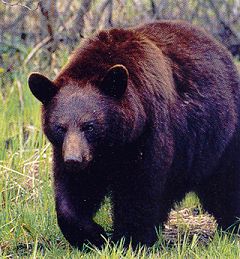
As for cartridges, you can use anything from .41 Magnum up to the .500 S&W. One of the most experienced hunters I’ve met says that any big-bore cartridge that throws a solid bullet weighing 200 grains or more at 1,000 fps or more is a thorough ticket-puncher for any black bear. By that standard, a heavy .44 Special or .45 Colt handload in the right gun would serve admirably.
Wayne Bosowicz carried a .357 Magnum Colt Python for years. Then he encountered a situation in which a charged-up bear came down from a tree and tore into his hounds and soaked up an entire cylinder full of 158-grain bullets in its chest without slowing down. Bosowicz immediately changed over to a Ruger Blackhawk in .41 Magnum, which has never failed to stop a bear.
Bullet selection is probably more important than anything, in fact. A black bear is tough-muscled with thick fur, hide and fat layers. You need a bullet that will penetrate through all that, and most hollowpoints used for .41-, .44- and .45-caliber commercial cartridges and handloads aren’t good choices. Bosowicz uses commercial Remington 210-grain JSP softnose loads in his .41 Magnum, and recommends any similarly structured loads. In .44 Magnum a 240-grain JSP, or a 220-grain (or heavier) silhouette-style bullet like Federal loads commercially, or Sierra and other bullet-makers offer as components, would be a good choice.
A jacketed softpoint powered for complete penetration through an average size bear is probably a better choice than a hard-cast SWC solid. The JSP will deform when penetrating, create a larger disruption channel, and if it goes all the way through, will leave a larger exit wound than will a hard, non-deforming cast bullet. If cast bullets are to be used, a medium-hard alloy with good deformation potential is a better selection.
The specific choice is yours, but if you use a minimum .40 caliber, a minimum 200-grain solid deformable bullet and a minimum of 1,000 fps velocity from your chosen gun, you’ll have a handgun load that will take any bear that shows itself. If you can stop shaking long enough to shoot.
Continue to next section “Living History: The Bear Hunter”
Handgunning for Bear may be read in the November 2006 issue of Peterson’s Hunting magazine. See page 72.
Read more about Handgun Bear Hunting with Foggy Mountain Guide Service.
Info about Maine Bear Hunts with Foggy Mountain Guide Service.
Read more Hunting Guide Magazine Articles about Foggy Mountain Guide Service.
Return to Bear Hunting Home Page.
